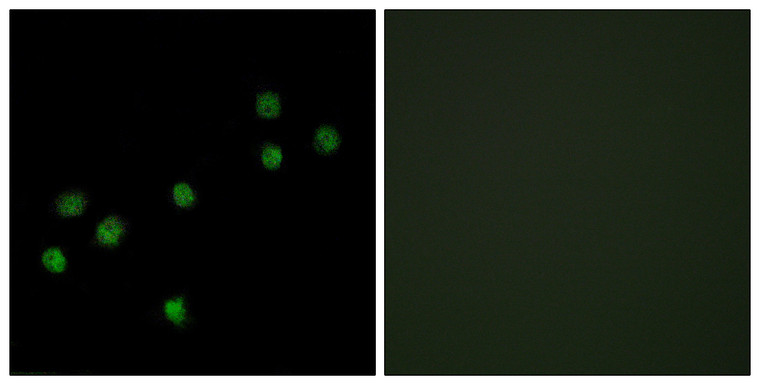| Host: |
Rabbit |
| Applications: |
IHC/IF/ELISA |
| Reactivity: |
Human/Rat/Mouse |
| Note: |
STRICTLY FOR FURTHER SCIENTIFIC RESEARCH USE ONLY (RUO). MUST NOT TO BE USED IN DIAGNOSTIC OR THERAPEUTIC APPLICATIONS. |
| Short Description: |
Rabbit polyclonal antibody anti-Histone H3-like centromeric protein A (1-50 aa) is suitable for use in Immunohistochemistry, Immunofluorescence and ELISA research applications. |
| Clonality: |
Polyclonal |
| Conjugation: |
Unconjugated |
| Isotype: |
IgG |
| Formulation: |
Liquid in PBS containing 50% Glycerol, 0.5% BSA and 0.02% Sodium Azide. |
| Purification: |
The antibody was affinity-purified from rabbit antiserum by affinity-chromatography using epitope-specific immunogen. |
| Concentration: |
1 mg/mL |
| Dilution Range: |
IHC 1:100-1:300IF 1:200-1:1000ELISA 1:10000 |
| Storage Instruction: |
Store at-20°C for up to 1 year from the date of receipt, and avoid repeat freeze-thaw cycles. |
| Gene Symbol: |
CENPA |
| Gene ID: |
1058 |
| Uniprot ID: |
CENPA_HUMAN |
| Immunogen Region: |
1-50 aa |
| Specificity: |
CENP-A Polyclonal Antibody detects endogenous levels of CENP-A protein. |
| Immunogen: |
The antiserum was produced against synthesized peptide derived from the human Centromeric Protein A at the amino acid range 1-50 |
| Function | Histone H3-like nucleosomal protein that is specifically found in centromeric nucleosomes. Replaces conventional H3 in the nucleosome core of centromeric chromatin that serves as an assembly site for the inner kinetochore. The presence of CENPA subtly modifies the nucleosome structure and the way DNA is wrapped around the nucleosome and gives rise to protruding DNA ends that are less well-ordered and rigid compared to nucleosomes containing histone H3. May serve as an epigenetic mark that propagates centromere identity through replication and cell division. Required for recruitment and assembly of kinetochore proteins, and as a consequence required for progress through mitosis, chromosome segregation and cytokinesis. |
| Protein Name | Histone H3-Like Centromeric Protein ACentromere Autoantigen ACentromere Protein ACenp-A |
| Database Links | Reactome: R-HSA-141444Reactome: R-HSA-2467813Reactome: R-HSA-2500257Reactome: R-HSA-5663220Reactome: R-HSA-606279Reactome: R-HSA-68877Reactome: R-HSA-9648025 |
| Cellular Localisation | NucleusChromosomeCentromereLocalizes Exclusively To Sites Of Kinetochore Assembly In CentromeresOccupies A Compact Domain At The Inner Kinetochore Plate Stretching Across 2 Thirds Of The Length Of The Constriction But Encompassing Only One Third Of The Constriction Width And HeightPhosphorylation At Ser-68 During Early Mitosis Abolishes Association With Chromatin And Centromeres And Results In Dispersed Nuclear Location |
| Alternative Antibody Names | Anti-Histone H3-Like Centromeric Protein A antibodyAnti-Centromere Autoantigen A antibodyAnti-Centromere Protein A antibodyAnti-Cenp-A antibodyAnti-CENPA antibody |
Information sourced from Uniprot.org
12 months for antibodies. 6 months for ELISA Kits. Please see website T&Cs for further guidance








